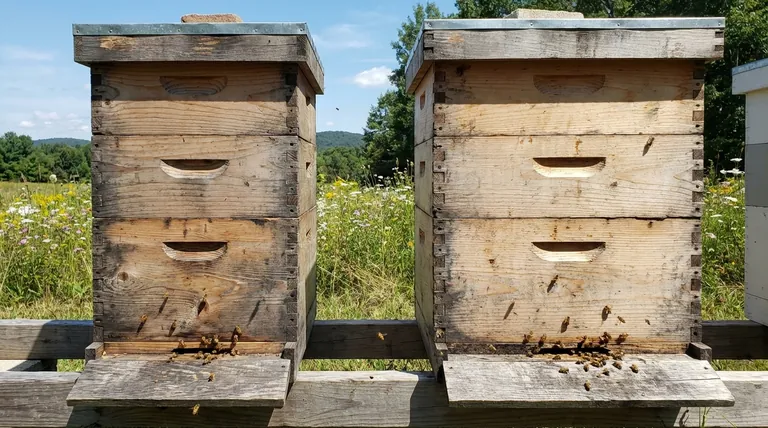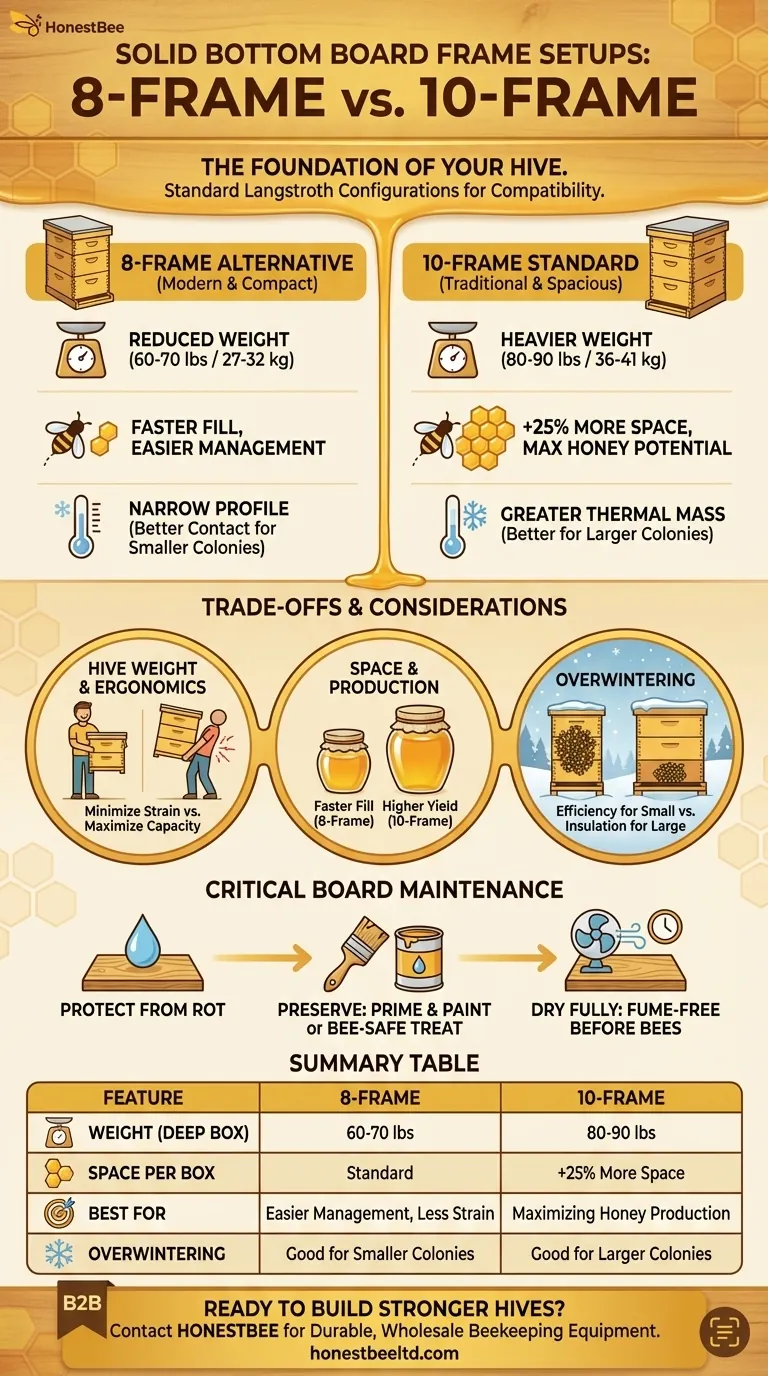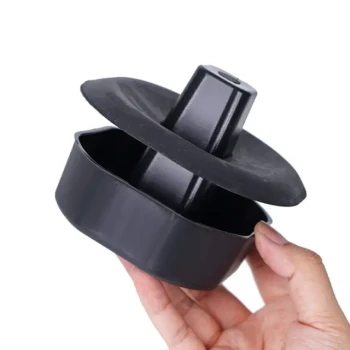In short, solid bottom boards are manufactured for the two most common Langstroth hive configurations: the 8-frame and the 10-frame setup. This standardization ensures they are compatible with the vast majority of hive bodies, supers, and other equipment used by beekeepers today.
The choice between an 8-frame and 10-frame setup is one of the most fundamental decisions a beekeeper makes. It's not just about the number of frames; it's a strategic decision that balances hive weight, honey production potential, and overwintering efficiency.

The Two Standard Setups: 8-Frame vs. 10-Frame
Your solid bottom board serves as the foundation for the entire hive structure. The size you choose—8-frame or 10-frame—will dictate the dimensions of all the hive bodies and supers you stack on top of it.
The 10-Frame Standard
The 10-frame hive is the traditional and most widely-used configuration. It was the original design for the Langstroth hive and is often considered the industry standard.
This setup provides more interior space per box, which can support a larger bee population and greater storage capacity for both brood and honey.
The 8-Frame Alternative
The 8-frame hive is a popular modern alternative that uses the same standard Langstroth frame size but in a narrower, more compact box.
Its primary advantage is reduced weight. A fully loaded 8-frame honey super is significantly lighter than its 10-frame counterpart, making it a preferred choice for beekeepers who want to minimize physical strain.
Understanding the Trade-offs
Choosing a frame setup is not about right or wrong; it's about what best fits your goals and physical abilities. Each configuration presents a distinct set of advantages and disadvantages.
Hive Weight and Ergonomics
This is the most significant difference. A deep 10-frame hive body full of brood, pollen, and honey can weigh 80-90 pounds (36-41 kg). A similar 8-frame box is closer to 60-70 pounds (27-32 kg).
For beekeepers with back problems or limited strength, the lighter weight of the 8-frame system is a decisive advantage.
Space and Honey Production
A 10-frame hive offers 25% more space per box. This means a larger brood nest and more room for honey storage, potentially leading to higher honey yields per hive.
With an 8-frame hive, the colony may fill the boxes faster, requiring the beekeeper to add supers more frequently to prevent swarming and provide storage space.
Overwintering Considerations
A 10-frame hive has greater thermal mass, which can help insulate the colony during winter. However, a smaller colony may struggle to heat the larger, emptier space.
An 8-frame hive's narrower profile means the winter cluster can more easily span the width of the hive, staying in better contact with its honey stores on adjacent frames. This can be an advantage, particularly for smaller colonies.
A Note on Board Maintenance
Regardless of the size you choose, the lifespan of your solid bottom board depends on proper care.
The Importance of Protection
The bottom board is exposed to moisture from the ground and precipitation. Untreated wood will rot, compromising the integrity of your hive and the health of your bees.
Two Methods for Preservation
To maximize its lifespan, you should either prime and paint the exterior surfaces with a quality outdoor latex paint or treat the raw wood with a bee-safe wood preservative, such as copper naphthenate.
Critical Safety Step
Always allow the bottom board to fully dry and air out until it is completely fume-free. Introducing bees to a hive with wet paint or preservative fumes can be harmful or fatal to the colony.
Making the Right Choice for Your Goal
Your decision should be based on a clear understanding of your personal beekeeping objectives.
- If your primary focus is maximizing honey production and you can manage heavy lifting: The 10-frame setup offers the most space for colony expansion and storage.
- If your primary focus is easier hive management and reduced physical strain: The 8-frame setup is the clear winner for its lighter, more manageable components.
- If your primary focus is overwintering success: Both can succeed, but consider the 8-frame for smaller colonies and the 10-frame for larger, more robust ones.
By aligning your equipment with your goals, you set a strong foundation for a successful and enjoyable beekeeping journey.
Summary Table:
| Feature | 8-Frame Setup | 10-Frame Setup |
|---|---|---|
| Weight (Deep Box) | 60-70 lbs (27-32 kg) | 80-90 lbs (36-41 kg) |
| Space per Box | Standard | 25% More Space |
| Best For | Easier Management, Less Strain | Maximizing Honey Production |
| Overwintering | Good for smaller colonies | Good for larger colonies |
Ready to Build a Stronger Hive?
Choosing the right bottom board is the first step to a thriving apiary. At HONESTBEE, we supply durable, precision-made solid bottom boards and complete beekeeping equipment setups for commercial apiaries and distributors.
We understand the unique demands of large-scale operations. Our wholesale-focused approach ensures you get the reliable, standardized equipment you need to manage your hives efficiently and profitably.
Contact our expert team today to discuss your specific needs and discover how HONESTBEE can be your trusted partner in beekeeping success.
Visual Guide

Related Products
- Langstroth Solid Bottom Board for Beekeeping
- Langstroth Screen Bottom Board for Beekeeping Wholesale
- Australian Pine Wood Langstroth Screen Bottom Board for Wholesale
- HONESTBEE Professional Frame Wiring Board and Jig
- HONESTBEE Durable Frame Wiring Board with Integrated Tensioner
People Also Ask
- What are the characteristics of a solid bottom board? A Guide to Hive Foundation & Climate Control
- What is the recommendation for bottom boards in top bar hives? Choose the Right Foundation for Your Climate
- How is the solid bottom board constructed to ensure durability? Built for Longevity with Quality Wood & Beeswax
- What is the recommended approach for choosing between different types of hive boards if you have multiple hives?
- What factors should be considered when choosing between a solid and screened bottom board? Make the Right Choice for Your Hive's Health



















